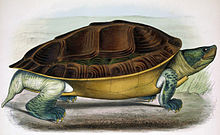| Burmese roofed turtle | |
|---|---|
 | |
| Female | |
| Scientific classification | |
| Kingdom: | Animalia |
| Phylum: | Chordata |
| Class: | Reptilia |
| Order: | Testudines |
| Suborder: | Cryptodira |
| Superfamily: | Testudinoidea |
| Family: | Geoemydidae |
| Genus: | Batagur |
| Species: | B. trivittata |
| Binomial name | |
| Batagur trivittata | |
| Synonyms[3] | |
| |
The Burmese roofed turtle (Batagur trivittata) is one of six species of turtle in the genus Batagur of the family Geoemydidae.[2] It is endemic to Myanmar, but was believed to be extinct until rediscovered in 2002.[4]
The female turtle grows significantly larger than the male and reaches sizes similar to that of a steering wheel; the males' color transforms during breeding season in which their usually green heads turn a bright chartreuse-yellow with bold black markings.[5]
Burmese roofed turtles remain very rare in the wild as there are only 5 known females in the wild.[4][6]
An individual was seen in 2007 in Qingping Market in Guangzhou, China.[7]
Conservation efforts
Conservation projects have been successful and several hundred Burmese roofed turtles are now kept in the Yadanabon Zoological Gardens in Mandalay and a turtle conservation center in Lawkananda Park, Bagan.[4][6] As of 2020, conservation efforts have successfully grown the population of turtles to 1,000 animals in captivity; some have been released to the wild.[5] In the years that followed, researchers found several specimens of the Burmese roofed turtle and took them to captivity.[8]
References
- ^ Platt, K.; Horne, B. D.; Praschag, P. (2019). "Batagur trivittata". IUCN Red List of Threatened Species. IUCN. 2019: e.T10952A499836. doi:10.2305/IUCN.UK.2019-1.RLTS.T10952A499836.en.
- ^ a b Rhodin, Anders G.J.; van Dijk, Peter Paul; Inverson, John B.; Shaffer, H. Bradley (2010-12-14). "Turtles of the world, 2010 update: Annotated checklist of taxonomy, synonymy, distribution and conservation status" (PDF). Chelonian Research Monographs. 5: 000.107–000.108. doi:10.3854/crm.5.000.checklist.v3.2010. ISBN 978-0965354097. Archived from the original (PDF) on 2011-07-17.
- ^ Fritz, U.; Havaš, P. (2007). "Checklist of Chelonians of the World" (PDF). Vertebrate Zoology. 57 (2): 226. ISSN 1864-5755. Archived from the original (PDF) on 2011-05-01. Retrieved 29 May 2012.
- ^ a b c Turtle Survival Alliance (8 April 2011). TSA Board Members Inspect the New Facilities in Myanmar. Archived 2013-10-02 at the Wayback Machine Accessed 27 March 2012.
- ^ a b Nuwer, Rachel (2020-09-03). "A Turtle With a Permanent Smile Was Brought Back From Extinction". The New York Times. ISSN 0362-4331. Retrieved 2020-09-03.
- ^ a b Wildlife Conservation Society. (2017, April 11). Egg hunt: Scientists discover eggs of one of world's most endangered turtles. ScienceDaily. Retrieved April 24, 2017 from www.sciencedaily.com/releases/2017/04/170411125936.htm
- ^ Gerald Kuchling, China Market: Turtle market survey in China reveals disturbing number of Myanmar endemics and critically endangered species, Turtle Survival Alliance Magazine, 2007, p. 8-9. (Includes a photo of the specimen)
- ^ Platt, Steve. "Burmese Roofed Turtles Return to the Wild".
Weblinks
